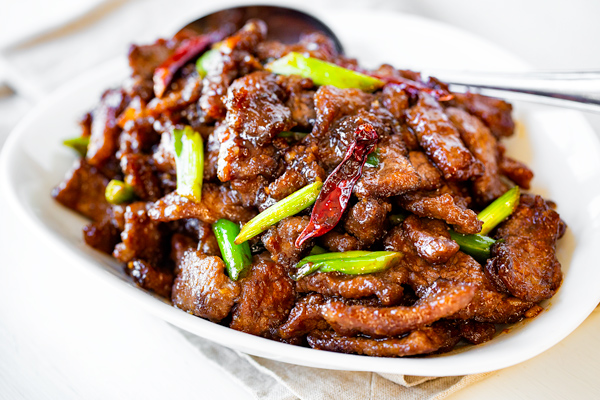Mongolian beef is a popular Chinese takeout dish featuring tender strips of beef stir-fried with vegetables in a sweet and savory brown sauce. With its rich flavor and tender texture, it’s easy to overindulge. But is Chinese Mongolian beef actually a healthy choice?
I took a closer look at the nutrition facts of this beloved beef stir-fry. Keep reading for a complete breakdown of the health pros and cons.
A Look at the Ingredients
To determine if Mongolian beef is healthy, we first need to examine what goes into it:
- Beef – usually flank, sirloin or round, sliced thinly
- Onions, carrots, bell peppers – the most common veggies
- Soy sauce, hoisin – for flavor
- Cornstarch – helps thicken the sauce
- Oil – for stir-frying, often vegetable or canola
At its core, Mongolian beef is a balanced combo of lean protein, vegetables, and sauce. But preparation technique and portion size impact just how healthy it is.
The Potential Nutrition Pros
When made properly Mongolian beef can provide some nutritional benefits
-
Protein – lean beef is an excellent source, aiding muscle growth and keeping you full.
-
Iron – beef contains heme iron, which is highly bioavailable compared to plant sources.
-
Vitamin A – from carrots and peppers; supports immune function.
-
Vitamin C – peppers provide this antioxidant vitamin.
-
Zinc – beef contains high levels of this immune-boosting mineral.
-
Fiber – onions, carrots, and bell peppers supply gut-healthy fiber.
So you can see Mongolian beef delivers complete nutrition from both the beef and veggie components when servings are controlled.
Where It Falls Short on Health
However, there are some potential downsides to consider:
-
High sodium – soy sauce and hoisin add a lot of sodium if overused.
-
Saturated fat – beef contains saturated fat, which should be limited.
-
Low vegetable content – often heavy on the beef but light on veggies.
-
Refined carbs – white rice or noodles commonly served alongside.
-
Large portions – dishes at restaurants are often 2-3 servings worth of food.
To make the most of Mongolian beef’s nutrition, watch the sodium, opt for lean beef, load up on the veggies, and control portions.
Tips for a Healthy Version
Here are some easy ways to tweak Mongolian beef to make it healthier:
-
Use lean beef like sirloin or flank steak.
-
Load up on vegetables – double the amount that restaurants use.
-
Go light on soy sauce and hoisin to cut sodium.
-
Serve with brown rice or quinoa instead of white rice.
-
Drink water with the meal to counter the sodium.
-
Box half the dish to take home before overeating.
-
Add a side salad for extra vegetables and nutrition.
The Verdict
Mongolian beef can be a nutritious dish when made properly. It provides protein, important vitamins and minerals, and vegetables. Just be mindful of sodium, saturated fat, and portions.
Overall, enjoying Mongolian beef occasionally as part of a balanced diet is perfectly healthy for most people. With a few simple tweaks, you can feel good about indulging in this beefy, saucy stir-fry.

More Asian Inspired Recipes
Looking for more quick and easy Asian dishes? Try these next.
- Download
- Send to your inbox
- ▢ 2 tbsp. low sodium soy sauce
- ▢ 1 tsp. sugar (leave out for low carb/Clean eating)
- ▢ 1 tsp. cornstarch
- ▢ 1 tbsp. rice vinegar
- ▢ 1 tbsp. hoisin sauce
- ▢ 2 tsp. Asian garlic chili paste (like sambal oelek)
- ▢ 2 tsp. vegetable oil
- ▢ 1 tbsp. ginger, minced
- ▢ 1 garlic clove, minced
- ▢ 1 lb. lean sirloin beef, thinly sliced across the grain .
- ▢ 8 green onions, chopped
Like this Recipe? Try our Meal Plans!
- Weekly Meal Plans
- Easy Shopping List
- Healthy, Low Carb, & Vegetarian
- Nutritional Information
Switch to prevent your screen from going dark.
Stir together the soy sauce, sugar, cornstarch, rice vinegar, hoisin, and chili paste.
Heat the oil in a nonstick skillet over medium high heat. Add the ginger, garlic, and beef. Cook for 2-3 minutes until beef is browned. Add the green onions and cook for 30 seconds. Add the sauce and cook for 1-2 minutes, stirring constantly, until it thickens.
* Percent Daily Values are based on a 2,000 calorie diet. Your daily values may be higher or lower depending on your calorie needs.
The Nutritional Values provided are estimates only and may vary based on the preparation method.
How to make Mongolian Sauce?
The key to making Mongolian beef is the sweet, savory, and slightly spicy sauce. It adds so much flavor to the dish and is addictively delicious.
Whenever I make this dish, I make a big batch and put it in the fridge for quick stir-fries or to put on top of vegetables.
Heres how to make a big batch of lightened-up Mongolian stir fry sauce.
- 1/2 cup low sodium soy sauce
- 1/4 cup rice vinegar
- 1/4 cup hoisin sauce
- 3 tbsp. ginger, minced
- 3 garlic cloves, minced
- 2.5 tbsp Asian garlic chili paste (like sambal oelek)
- 2.5 tbsp vegetable oil (or coconut oil)
- 4 tsp. sugar (leave out for low carb/Clean eating)
- 4 tsp. cornstarch
Simply mix together all the ingredients and store the sauce in an airtight container in the fridge.
Use for quick stir-fries, over veggies, over rice or grains, and to cook any lean proteins. Brown a pound of lean ground turkey, add a bag of coleslaw mix, and this sauce. It’s one of my favorite quick meals. So good and so easy.
P.F. Chang’s Mongolian Beef Secrets Revealed
FAQ
How many calories are in Chinese mongolian beef?
Is mongolian beef fatty?
What meat is mongolian beef made of?
Why Mongolian meat is good?
